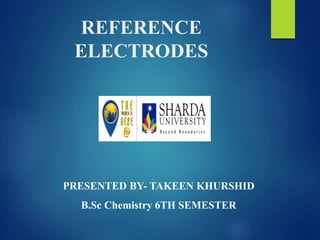refernce electrodes
•Download as PPTX, PDF•
18 likes•13,652 views
reference electrodes
Report
Share
Report
Share

Recommended
Recommended
More Related Content
What's hot
What's hot (20)
Engineering Chemistry Module 1 : Reference Electrodes

Engineering Chemistry Module 1 : Reference Electrodes
Viewers also liked
Viewers also liked (8)
Similar to refernce electrodes
Potentiometry - Electrochemical cell -Construction and working of reference (Standard hydrogen, silver chloride electrode and calomel electrode)
Indicator electrodes (metal electrodes and glass electrode)
Methods to determine end point of potentiometric titration
and applications
Potentiometry is the method to find the concentration of solute in
A given solution by measuring the potential between two Electrodes
(reference and Indicator electrode) . Potentiometric titration involves
the measurement of the potential of the indicator electrode and
reference electrode.
In potentiometric titration reference and indicator electrodes are
immersed in the solution of particular analyte (titrand) and
potential of indicator electrode is measured with relation to
reference electrode.
Titrant is added in analyte (Titrand) and change in potential is noted
down.
At the end point there is sharp change in potential on indicator
electrode.
Graph is plotted between the indicator electrode potential and
volume of titrant added.
This method is used for determination of sharp end point.
Types of Potentiometric Titration
1. Acid-base titration 2. Redox Titration 3.Complexometric titration 4. Precipitation Titration
Potentiometry, Electrochemical cell, construction and working of indicator an...

Potentiometry, Electrochemical cell, construction and working of indicator an...Vandana Devesh Sharma
Similar to refernce electrodes (20)
Basics of Electrochemistry and Electrochemical Measurements

Basics of Electrochemistry and Electrochemical Measurements
Potentiometry, Electrochemical cell, construction and working of indicator an...

Potentiometry, Electrochemical cell, construction and working of indicator an...
CBSE Class 12 Chemistry Chapter 3 (Electrochemistry) | Homi Institute

CBSE Class 12 Chemistry Chapter 3 (Electrochemistry) | Homi Institute
Instrumental methods ii and basics of electrochemistry

Instrumental methods ii and basics of electrochemistry
Ion sensitive electrode & gas sensitive electrode..

Ion sensitive electrode & gas sensitive electrode..
Recently uploaded
Recently uploaded (20)
On National Teacher Day, meet the 2024-25 Kenan Fellows

On National Teacher Day, meet the 2024-25 Kenan Fellows
Simple, Complex, and Compound Sentences Exercises.pdf

Simple, Complex, and Compound Sentences Exercises.pdf
QUATER-1-PE-HEALTH-LC2- this is just a sample of unpacked lesson

QUATER-1-PE-HEALTH-LC2- this is just a sample of unpacked lesson
Unit 3 Emotional Intelligence and Spiritual Intelligence.pdf

Unit 3 Emotional Intelligence and Spiritual Intelligence.pdf
dusjagr & nano talk on open tools for agriculture research and learning

dusjagr & nano talk on open tools for agriculture research and learning
Exploring_the_Narrative_Style_of_Amitav_Ghoshs_Gun_Island.pptx

Exploring_the_Narrative_Style_of_Amitav_Ghoshs_Gun_Island.pptx
refernce electrodes
- 1. REFERENCE ELECTRODES PRESENTED BY- TAKEEN KHURSHID B.Sc Chemistry 6TH SEMESTER
- 2. REFERENCE ELECTRODE An ideal reference electrode is one that maintains a constant potential irrespective of the amount of current (if any) that is passed through it.
- 3. Voltammetric methods are those in which current passing in an electrochemical cell is measured as a function of the potential applied to the working electrode. Potential, by definition, is not something that can be directly measured. Rather, the measurement of applied potential requires that a reference point first be established, and individual potentials be measured relative to that reference point. This is accomplished by placing a second electrode, called the reference electrode, in the cell and measuring potential as the energy difference between the two electrodes, called the reference electrode.
- 4. Reference electrodes should be constructed using half-cell components that are stable over time and with changing temperature, present at well-defined values of activity. They should possess fixed, reproducible electrode potentials.
- 5. The reference half-cell with which most of us are familiar is the standard hydrogen electrode (SHE), composed of an inert solid like platinum on which hydrogen gas is adsorbed, immersed in a solution containing hydrogen ions at unit activity. The half-cell reaction for the SHE is given by H+ + e-→ ½ H2 (g) ( 1atm)
- 6. The potential of the standard hydrogen electrode is arbitrarily assigned the value of zero (0.000) volts at 250 C. When standard hydrogen electrode is coupled with another electrode, the EMF of the cell thus formed will evidently be equal to the potential of that electrode to which it is coupled. The potentials obtained in this way are called relative potentials, or electrode potentials on the hydrogen scale.
- 7. Practical application of the SHE is limited by the difficulties in preparing solutions containing H+ at unit activity and maintaining unit activity for H2 (g) in the half-cell. Most experiments carried out in aqueous solutions utilize one of two other common reference half cells – the saturated calomel electrode (SCE) or the silver-silver chloride electrode (Ag/AgCl).
- 8. The Calomel Electrode Calomel electrode is most widely used as secondary reference electrode. The standard calomel electrode (SCE) comprises of wide glass – tube fitted with narrow side tubes. Pure mercury is placed at the bottom of the wide tube and covered with a paste of mercurous chloride (calomel). A solution of KCl is introduced above the paste. A saturated KCl solution may also be used. A Pt wire sealed into a glass tube is used to make electrical contact. The side tube containing KCl solution provides the salt bridge, which connects the electrode to any other electrode. The calomel electrode is represented as Cl– (1 M) Hg2Cl2 , Hg And the half-cell reaction is written as Hg2Cl2 + 2e– 2Hg + 2Cl–
- 9. Saturated Calomel Electrode Electrode is mercury coated with calomel (Hg2Cl2) Electrolyte is a solution of potassium chloride.
- 10. Silver/Silver Chloride Electrode (Ag/AgCl) The silver/silver chloride reference electrode is composed of a silver wire (Ag) that has been coated with a layer of solid silver chloride (AgCl), immersed in a solution that is saturated with KCl and AgCl. The half cell reaction is AgCl (s) + e - ↔Ag (s) + Cl-(sat’d)
- 11. Both the SCE and the Ag/AgCl reference electrodes offer stable half-cell potentials that do not change over time
- 12. THANK YOU!!